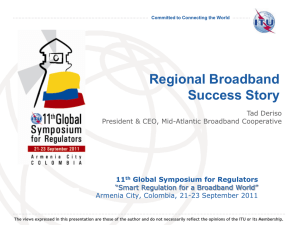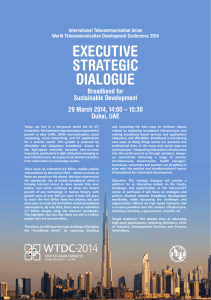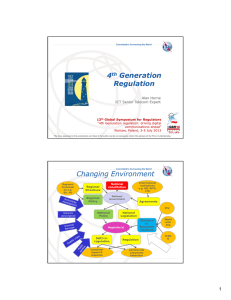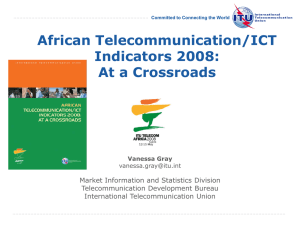The More Things Change, the More they Stay the Same:
advertisement
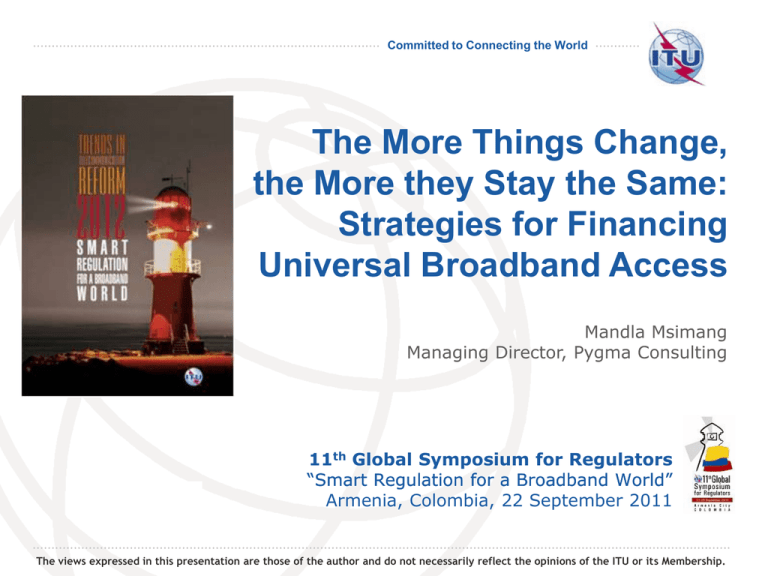
Committed to Connecting the World The More Things Change, the More they Stay the Same: Strategies for Financing Universal Broadband Access Mandla Msimang Managing Director, Pygma Consulting 11th Global Symposium for Regulators “Smart Regulation for a Broadband World” Armenia, Colombia, 22 September 2011 The views expressed in this presentation are those of the author and do not necessarily reflect the opinions of the ITU or its Membership. Committed to Connecting the World …the Broadband Revolution Mobile voice and SMS, non considered “basic” in many countries Access for: 90% of global population, 80 percent of people living in rural areas 1.6 b users globally are “chatting”, “tweeting,” “blogging” and browsing (i.e. have Internet access) >5 billion people have never experienced the Internet or have only experienced it through International public/shared access Telecommunication Union Source: ITU Eye 2 Committed to Connecting the World The more things change…. Basic Voice and Data Focus on Supply USF Affordability, Accessibility, Availability • Internet and Broadband • Focus on Supply and Demand • USAF and Output Based Aid • AAA + Awareness, Ability International Telecommunication Union Committed to Connecting the World The more they stay the same…. Market reform and good regulation remain the foundations for UAS policy and strategy; UAS interventions have to be competitively and technologically neutral; and Availability, affordability and accessibility - still pillars of UAS; The UAS funding question persists (now for universal broadband access). International Telecommunication Union Committed to Connecting the World Flavors of Funding CASH (DIRECT) IN KIND (INDIRECT) PRIVATE Infrastructure rollout Device subsidies Mandatory USAF obligations PUBLIC Equity investment Private Public Partnership Disbursement of USAF subsidies Commitment of Stimulus plan funds Tax incentives Spectrum licensing Rights of way Infrastructure Sharing Risk guarantees International Telecommunication Union Committed to Connecting the World Funding Parameters Competition as a starting point for funding broadband Public broadband funding to be supported by minimum policy and regulatory decisions: Any legal requirements relating to public financing mechanisms should be considered EU State Aid Rules, South Africa’s PPP Manual the legal scope and mandate of a USAF if one is in place, and national or municipal supply chain regulations that would apply to ICT sector procurement; Country specific definition of “universal service” and “universal access;” Determination of national targets with respect to UA and US; and Determination of access gaps and a related decision on what constitutes “underserviced areas” and who are eligible International beneficiaries. Telecommunication Union Committed to Connecting the World Ensure Adequate “ROI” Supply Demand PCs/Tablets/laptops… Digital Literacy Last Mile/Metros/Local “Anchor” tenancy, Eservices Backbone networks Content and Applications International connectivity Users The strengths of a funding mechanism can be assessed relative to: economic efficiency equity competitive neutrality technology neutrality certainty Transparency cost effectiveness International Telecommunication Union Source: Author, OECD Committed to Connecting the World 3 Main Public Funding Models: Increasing reliance on Public Funding for high cost broadband networks Ownership or Equity Participation in broadband projects •Australia, Brazil, New Zealand, Malaysia, Sweden and South Africa; Public Private Partnerships •broadband infrastructure deployment projects undertaken in France, Thailand, Kenya and Tanzania; Provision of financial incentives and subsidies •Latin American countries through the use of first-generation Universal Service Funds •China, Japan, the USA and EU through broadband stimulus packages. International Telecommunication Union Source: The Economist Committed to Connecting the World USAFs Still a Popular Approach Increased role: Facilitator to stimulate the market, Creating demand for advanced ICT connectivity and services (e.g. school connectivity, user support) rural/underserved broadband networks International Telecommunication Union Source: ITU Eye Committed to Connecting the World Funds: Lifting the Main Roadblocks Some Mistakes •over-collected and under-spent; •overspent, i.e. provided subsides for unsuccessful projects, or for inefficient use in projects; •become involved in project implementation; •have not made their collections, and disbursements public; •submitted funds to central fund in Treasury/Ministry of Finance where ICT sector contributions have been used to subsidise non-ICT sector projects (e.g. road projects, property projects) •Implemented projects that distort the market; •Created dependence on on-going funding (subsidies that are not “smart”); •Favoritism •Mismanagement of Funds And Some Successes •Clear rules, •Effective public consultation processes, and •Transparent administrative processes. •Sweden (recognition that demand is unclear), financing of rural broadband networks is linked to the following conditions: •a requirement for nondiscrimination, and open access basis to third parties for 7 years; •a requirement to provide passive and active infrastructure (incl. ducts, dark fibre, bitstream access) •a requirement to provide access to at least 3 operators at infrastructure level •claw back condition in contracts avoids “overfunding” (maintained International for 5 years). Telecommunication Union Committed to Connecting the World Conclusion Achieving high “ROI” which is aligned with public interest relies on: Having clear universal broadband access strategies and definitions Having the right policy and regulatory framework in place – one that does not distort the market Relying on a combination of equity investments, financial incentives and subsidies, PPPs, etc, as appropriate, applied only where the market is well understood, Clear idea of supply side and demand side levers that need to be pushed in order to get the desired result. Good governance and good project design, monitoring and evaluation International Telecommunication Union
